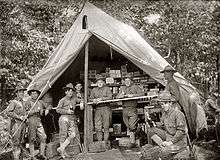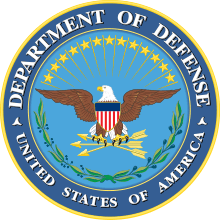Army and Air Force Exchange Service
 | |
| Department store, Government agency | |
| Industry | Retail |
| Founded |
July 25, 1895 (General Orders No. 46) June 6, 1941 (Army Exchange Service) |
| Headquarters |
3911 South Walton Walker Boulevard, Dallas, Texas, United States 75236 |
Number of locations | 2,700 (all facilities) |
Key people | Tom Shull, Director/CEO |
| Revenue | |
Number of employees | 35,000 |
| Parent | United States Department of Defense (1895–present) |
| Website | www.shopmyexchange.com |
The Army & Air Force Exchange Service (AAFES, also referred to as The Exchange) is the retailer on U.S. Army and Air Force installations worldwide. The Exchange is headquartered in Dallas, Texas, and its Director/chief executive officer is Tom Shull.
The oldest and the largest of the Department of Defense's exchange services and in addition to their retail support for the military, the Exchange also outfits troops with combat uniforms below cost[3], and serves approximately 3.2 million discounted school lunches per year for children attending Department of Defense Schools overseas.[4]
Starting Veterans Day, Nov. 11, 2017, military exchanges started offering online exchange shopping privileges to an estimated 18.5 million honorably discharged veterans.[5] The exchanges launched www.VetVerify.org in June 2017, allowing veterans to verify their eligibility ahead of the benefit's start date.[6]
History
Roots

For more than 100 years before the post exchange system was created, traveling merchants known as sutlers provided American soldiers with goods and services during times of war. Sutlers served troops at Army camps as far back as the French and Indian and Revolutionary wars.[7]
Complaints of sutlers charging premiums for substandard merchandise were widespread during the Civil War, and in 1867 the War Department created the post trader system. While intended to prevent the unscrupulous practices of sutlers, the post trader system still subjected troops to over-inflated prices and was rife with bribery and corruption.[8]
On Nov. 29, 1880, Col. Henry A. Morrow, seeking to quell disciplinary problems resulting from troops visiting disreputable places of amusement in nearby towns, established the first American military canteen at Vancouver Barracks. There, troops were provided newspapers and magazines, played billiards and cards, and could obtain light food and drink without leaving post.
The idea was so successful that other posts began establishing canteens across the frontier, providing troops with not only a place to socialize but obtain daily necessities at affordable prices. In 1889, the War Department issued General Orders No. 10, authorizing commanding generals to establish canteens at army posts. Like the modern-day exchange system, these canteens were largely financially self-sustaining.[9]
In February 1882, the secretary of war ordered that canteens be henceforth referred to as “post exchanges.” This change was due to the popular association of the word “canteen” with the bawdy, immoral behavior alleged to occur in the canteens of foreign armies. By 1895, post traders had been almost entirely replaced on Army posts by post exchanges.[10]
Early developments
On July 25, 1895, the War Department issued General Orders No. 46, directing commanders at every post to establish a post exchange “wherever practicable.” Post exchanges served two missions: first, “to supply the troops at reasonable prices with the articles of ordinary use, wear, and consumption, not supplied by the Government, and to afford them a means of rational recreation and amusement,” and second, “provide the means for improving the messes” through exchange profits.[11]
For the first 45 years of the exchange system, exchanges operated independently under the direction of each post’s commanding officer, meaning there was little uniformity between exchange locations. While the War Department did not centrally control exchange operations, it did hold commanding officers accountable for their financial assets. Exchanges were also subject to annual checks by the Inspector General’s office.
With the outbreak of World War I and subsequent expansion of the U.S. Army, it became clear that the existing post exchange system was not equipped to accommodate such a large-scale effort. Gen. John J. Pershing enlisted the help of civilian service organizations to provide canteen service overseas, though they proved to lack the equipment and experience necessary to fully meet the needs of downrange troops.[12]
Centralization
During the mobilization efforts leading up to World War II, the War Department increasingly looked for ways to upgrade its antiquated post exchange system. After completing a review of existing exchanges, Lt. Col. J. Edwin Grose concluded that the Army would need to “become the operator of an extensive chain store system with world wide [sic] branches” to sufficiently meet the demands of a large-scale war effort. In April 1941, an advisory committee of five prominent retail executives affirmed this notion, recommending the creation of a central organization to oversee exchange operations.
On June 6, 1941, the Army Exchange Service (AES) was created.[13] On July 26, 1948, AES was renamed the Army & Air Force Exchange Service, to reflect AES’ responsibility to serve the Air Force, which was created in 1947.[14]
Since its establishment, the Exchange has been involved in 14 major military operations (to include World War II, Korea, Vietnam, Grenada, Panama, the Balkans and Operations Enduring and Iraqi Freedom) as well as several dozen humanitarian and disaster relief contingencies.
Civilian leadership

In 2012, Tom Shull became the Exchange's first civilian Director/CEO, having previously served as an executive with Wise Foods, Inc., Hanover Direct, Inc., Barneys New York and Meridian Ventures. A West Point graduate, Shull served as an infantry company commander and held assignments at the White House and National Security Council.[15]
Under Shull's leadership, the Exchange has added merchandise from industry-leading brands such as Michael Kors and Disney to its assortment, reduced costs and made improvements to its website, ShopMyExchange.com. As of July 2017, the Exchange has established shipping centers inside 26 brick-and-mortar stores, reducing shipping costs and improving delivery times for customers.[16] Shull also spearheaded the Exchange's efforts to bring first-run movies to installation theaters.[4]
In 2015, Shull's emphasis on intensifying national brands, growing concessions and Express stores, strengthening the Exchange's web presence and reducing costs led the Exchange to record operating earnings of $402 million, every dollar of which was reinvested into the military community.[17] This performance, which occurred despite military personnel downsizing of 13 percent since 2011[16], represents an increase of three percentage points in terms of profitability, and is on par with or exceeds that of Walmart and Target.[18]
Veterans online shopping benefit
On May 8, 2012, Shull drafted a memorandum to the Under Secretary of Defense for Personnel and Readiness proposing that military exchanges be allowed to extend online shopping privileges to honorably discharged veterans[19].
Shull presented a business case for the veterans online shopping benefit to the Department of Defense’s Executive Resale Board in August 2014. Shull said the plan could generate more than $100 million for installation quality-of-life programs within three years[20]. The Executive Resale Board voted unanimously to recommend the proposal in August 2016[21].
On Jan. 13 2017, the Department of Defense announced that all honorably discharged veterans would be eligible to shop tax-free online military exchanges starting Nov. 11, 2017[22]. The expanded benefit is expected to make online exchange privileges available to an estimated 17 million to 21 million veterans.[4]
On June 5, 2017, military exchanges announced the launch of VetVerify.org, an online service where veterans can verify their eligibility to shop online exchanges. It was concurrently announced that some veterans who register would be selected to shop ahead of the Nov. 11 launch as beta testers.[23] By November, VetVerify.org had verified more than 225,000 veterans[5]
Structure and funding
Part of the Department of Defense, the Exchange is directed by a board of directors responsible to the secretaries of the Army and Air Force through the Chiefs of Staff. As a non-appropriated fund activity, the Exchange self-funds 98 percent of its operations, with revenue coming from the sale of goods and services. The majority of the 2 percent in appropriated funds is used to fund transporting goods overseas to Americans stationed abroad.[24]
Members of the Exchange's 13-member board of directors include Lt. Gen. Gina Grosso, Deputy of Chief of Staff for Manpower, Personnel and Services, Headquarters U.S. Air Force; Lt. Gen. Aundre Pigge, the Army's Deputy Chief of Staff, G-4; U.S. Army Sgt. Maj. Daniel A. Dailey and Air Force Chief Master Sgt. Kaleth O. Wright.[25]
Earnings
One hundred percent of Exchange earnings are invested back into the military community. Two-thirds of Exchange earnings support Army Morale, Welfare and Recreation (MWR), Air Force Services, and Navy and Marine Corps quality-of-life programs, while the remaining third is used for new store construction and facility costs at no cost to the federal government.[26]
In 2017, the Exchange reported $376 million in earnings[27]. Of this amount, $219 million was reinvested into installation quality-of-life programs including child development and fitness centers[28]. In the past 10 years, the Exchange has distributed more than $2.4 billion for MWR to fund quality-of-life improvements.[29]
Stores

The Exchange operates more than 2,700 facilities, including main stores, convenience stores, military clothing stores and theaters, across 50 U.S. states and 33 countries. Additionally, the Exchange has nearly 1,750 quick-serve restaurants such as Subway, Burger King, Popeyes Chicken, Taco Bell, Pizza Hut, Charley's Grilled Subs and Starbucks as well as over 3,600 concession operations.[24] Authorized patrons of the Exchange include members of Active Duty, members of the Reserves and National Guard, retired members of the U.S. uniformed services, recipients of the Medal of Honor, honorably discharged veterans certified 100% disabled by the United States Department of Veterans Affairs, or when hospitalized and their dependents by the presentation of the U.S. Uniformed Services Privilege and Identification Card.[30]
Modern base and post exchanges (called BX in the Air Force, PX in the Army) provide tax-free goods – including name brands such as Michael Kors, Coach, and Ralph Lauren – to authorized shoppers. In addition, some Exchanges host concession malls with a variety of vendors and storefronts.
In November 2010, the Exchange unveiled Freedom Crossing at Fort Bliss, a $100 million outdoor mall anchored by a 217,000-square-foot Exchange Main Store and including a children's play area, outdoor dining patios, shaded landscaped areas, outdoor seating, an outdoor fireplace, an interactive fountain, a lawn for community events and concerts, and more than 40 storefronts and restaurants. The mall is the first of its kind on a United States armed services base.[31][32]
Employees
The Exchange employs nearly 35,000 associates worldwide in the United States, Europe, the Pacific and the Middle East. Of these, about 27 percent are military spouses or dependents, 10 percent are veterans and 2 percent are active duty, reserves and the national guard.[24] The Exchange has been named a Military Friendly Employer by Victory Media, publisher of G.I. Jobs and Military Spouse magazine, for five consecutive years, most recently receiving the publisher's Silver Award.[33][34] In all, about 85 percent of the Exchange's associates are connected in some way to the military.[4]
Since 11 September 2001, 4,600 Exchange associates have deployed to combat zones in Iraq and Afghanistan to support troops in combat operations[27]. The Exchange currently operates 49 stores in contingency zones in countries such as Afghanistan, Kuwait, Iraq, Saudi Arabia, Jordan, Qatar, United Arab Emirates, Romania, Cyprus, Bosnia and Kosovo.[29]
Military Star Card
The Exchange also operates and funds the Exchange Credit Program (ECP), a program established by Congress in 1979 to protect service members from predatory lending and offer responsible credit solutions to customers.
The Exchange Credit Program's Military Star Card counts approximately 2 million cardholders from all branches of service, including qualified dependents, among its members. The Exchange Credit Program markets Military Star as the "one card solution" for all purchases made on military installations. Like the Exchange, the Exchange Credit Program contributes a significant portion of its earnings to morale, welfare and recreation programs, furnishing $639 million to MWR programs over the last 10 years.[35]
According to an October 2016 report by CreditCards.com, the Military Star Card has the lowest flat interest rate among retail-branded credit cards.[36]
See also
- Base exchange
- Canex, Canadian equivalent
- NAAFI, United Kingdom equivalent
- Navy Exchange
References
- ↑ "The Army & Air Force Exchange Service 2017 Annual Report" (PDF). The Army & Air Force Exchange Service. 10 July 2018.
- ↑ "The Army & Air Force Exchange Service 2016 Annual Report" (PDF). The Army & Air Force Exchange Service. 11 August 2017.
- ↑ "Across Europe and Tip of the Spear, Exchange Delivers a Lifeline to America". Army & Air Force Exchange Service. 27 July 2017.
- 1 2 3 4 Rubino, Joe (September 26, 2017). "Colorado-born Tom Shull has a gift for U.S. veterans: Tax-free online shopping". Denver Post. Retrieved September 27, 2017.
- 1 2 Ballentine, Claire (November 1, 2017). "Honorably discharged from the US military? You just got another benefit from Uncle Sam". Raleigh News & Observer. Retrieved November 2, 2017.
- ↑ "Your questions answered about the new veterans online shopping benefit". Military Times. 10 June 2017.
- ↑ Habgood, Carol; Skaer, Marcia (October 1994). One Hundred Years of Service: A History of the Army & Air Force Exchange Service (PDF). Army & Air Force Exchange Service. p. 1. ISBN 9995489228.
- ↑ "Post Exchange System". JAG Law Review. VIII (5): 21. September–October 1966. Retrieved September 5, 2017.
- ↑ Habgood, Carol; Skaer, Marcia (October 1994). One Hundred Years of Service: A History of the Army & Air Force Exchange Service (PDF). Army & Air Force Exchange Service. pp. 9–12. ISBN 9995489228.
- ↑ Habgood, Carol; Skaer, Marcia (October 1994). One Hundred Years of Service: A History of the Army & Air Force Exchange Service (PDF). Army & Air Force Exchange Service. pp. 16–18. ISBN 9995489228.
- ↑ "Post Exchange System". JAG Law Review. VIII (5): 33. September–October 1966. Retrieved September 5, 2017.
- ↑ Habgood, Carol; Skaer, Marcia (October 1994). One Hundred Years of Service: A History of the Army & Air Force Exchange Service (PDF). Army & Air Force Exchange Service. pp. 19–21. ISBN 9995489228.
- ↑ "Post Exchange System". JAG Law Review. VIII (5): 34. September–October 1966. Retrieved September 5, 2017.
- ↑ Habgood, Carol; Skaer, Marcia (October 1994). One Hundred Years of Service: A History of the Army & Air Force Exchange Service (PDF). Army & Air Force Exchange Service. p. 39. ISBN 9995489228.
- ↑ "Civilian CEO moves to modernize military's retail business". LATimes.com. Los Angeles Times. Retrieved 27 March 2013.
- 1 2 "Honorably discharged veterans will soon get to shop tax-free". APNews.com. Associated Press. Retrieved 11 August 2017.
- ↑ "Exchange director/CEO focuses on making life better for Airmen at Creech, Nellis AFBs". AerotechNews.com. Nellis Bullseye. Retrieved 4 November 2016.
- ↑ "This week, the Soldier for Life... – Soldier for Life | Facebook". www.facebook.com. Retrieved 6 March 2017.
- ↑ "AAFES chief: Let 22 million vets shop exchanges online". Stars & Stripes. June 5, 2014. Retrieved August 22, 2017.
- ↑ "AAFES makes 'business case' for allowing veterans to shop online". Stars & Stripes. August 21, 2014. Retrieved August 22, 2017.
- ↑ "The Pentagon is closer to extending a generous new benefit to millions of veterans". MilitaryTimes.com. August 16, 2016. Retrieved August 22, 2017.
- ↑ "DoD to Open Online Exchange Shopping to Veterans". defense.gov. January 13, 2017. Retrieved August 22, 2017.
- ↑ "Veterans can register now for chance at early access to online military exchange shopping". MilitaryTimes.com. June 5, 2017. Retrieved August 22, 2017.
- 1 2 3 "Exchange Quick Facts". ShopMyExchange.com. Army & Air Force Exchange Service. Retrieved 29 January 2016.
- ↑ "Exchange Leadeship". ShopMyExchange.com. Army & Air Force Exchange Service. Retrieved 11 January 2017.
- ↑ http://www.goodfellow.af.mil/News/ArticleDisplay/tabid/322/Article/614970/shopping-the-exchange-pays-224-million-in-dividends.aspxhttp://www.goodfellow.af.mil/News/ArticleDisplay/tabid/322/Article/614970/shopping-the-exchange-pays-224-million-in-dividends.aspx
- 1 2 "The Exchange By The Numbers". ShopMyExchange.com. Army & Air Force Exchange Service. Retrieved 10 July 2018.
- ↑ "Stuttgart Citizen". 2018-06-07. Retrieved 10 July 2018.
- 1 2 "Benefit Fact Sheet". MyArmyBenefits.com. U.S. Army. Retrieved 26 September 2016.
- ↑ "The Exchange – Exchange Stores – Authorized Patrons".
- ↑ Avila, Celina (5 November 2010). "More New Mall Opens on Fort Bliss". KVIA TV. Retrieved 29 January 2016.
- ↑ Poe, David (28 October 2010). "AAFES commander Casella said Freedom Crossing at Fort Bliss ready to shine Nov. 5". Army.mil. Retrieved 29 January 2016.
- ↑ "Is the Exchange (Army & Air Force Exchange Service) a Military Friendly Employer?". MilitaryFriendly.com. Victory Media. Retrieved January 11, 2017.
- ↑ "Army & Air Force Exchange Service named 'Military Friendly'". HookeleNews.com. Hookele – Pearl Harbor – Hickam News. Retrieved 29 December 2016.
- ↑ "About ECP". MyECP.com. Exchange Credit Program. Retrieved 29 January 2016.
- ↑ "30% Interest for a Store Credit Card". PR Newswire. PR Newsire. Retrieved October 20, 2016.
External links
| Wikimedia Commons has media related to Army & Air Force Exchange Service. |
